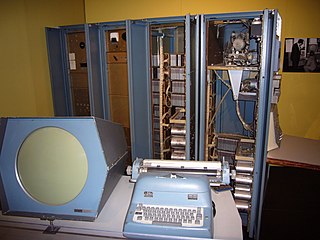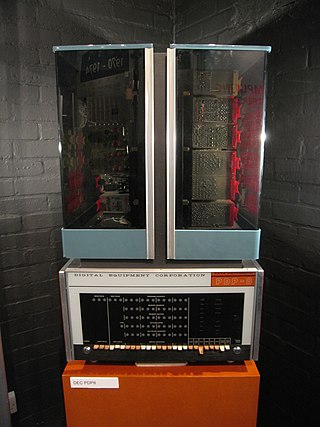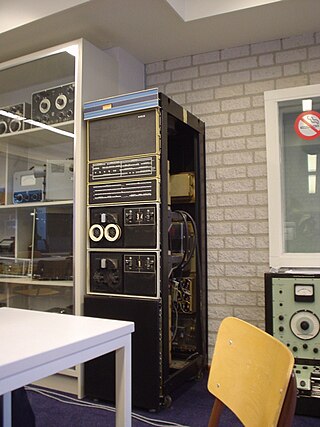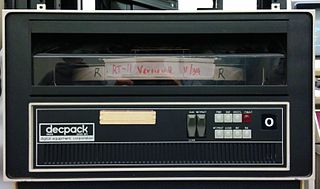
Digital Equipment Corporation, using the trademark Digital, was a major American company in the computer industry from the 1960s to the 1990s. The company was co-founded by Ken Olsen and Harlan Anderson in 1957. Olsen was president until he was forced to resign in 1992, after the company had gone into precipitous decline.

A minicomputer, or colloquially mini, is a type of smaller general-purpose computer developed in the mid-1960s and sold at a much lower price than mainframe and mid-size computers from IBM and its direct competitors. In a 1970 survey, The New York Times suggested a consensus definition of a minicomputer as a machine costing less than US$25,000, with an input-output device such as a teleprinter and at least four thousand words of memory, that is capable of running programs in a higher level language, such as Fortran or BASIC.

Programmed Data Processor (PDP), referred to by some customers, media and authors as "Programmable Data Processor," is a term used by the Digital Equipment Corporation from 1957 to 1990 for several lines of minicomputers.

The PDP-1 is the first computer in Digital Equipment Corporation's PDP series and was first produced in 1959. It is famous for being the most important computer in the creation of hacker culture at the Massachusetts Institute of Technology, Bolt, Beranek and Newman and elsewhere. The PDP-1 is the original hardware for playing history's first game on a minicomputer, Steve Russell's Spacewar!

The PDP-8 is a family of 12-bit minicomputers that was produced by Digital Equipment Corporation (DEC). It was the first commercially successful minicomputer, with over 50,000 units being sold over the model's lifetime. Its basic design follows the pioneering LINC but has a smaller instruction set, which is an expanded version of the PDP-5 instruction set. Similar machines from DEC are the PDP-12 which is a modernized version of the PDP-8 and LINC concepts, and the PDP-14 industrial controller system.

The PDP–11 is a series of 16-bit minicomputers sold by Digital Equipment Corporation (DEC) from 1970 into the late 1990s, one of a set of products in the Programmed Data Processor (PDP) series. In total, around 600,000 PDP-11s of all models were sold, making it one of DEC's most successful product lines. The PDP-11 is considered by some experts to be the most popular minicomputer.
RT-11 is a discontinued small, low-end, single-user real-time operating system for the full line of Digital Equipment Corporation PDP-11 16-bit computers. RT-11 was first implemented in 1970. It was widely used for real-time computing systems, process control, and data acquisition across all PDP-11s. It was also used for low-cost general-use computing.

The LINC is a 12-bit, 2048-word transistorized computer. The LINC is considered by some to be the first minicomputer and a forerunner to the personal computer. Originally named the Linc, suggesting the project's origins at MIT's Lincoln Laboratory, it was renamed LINC after the project moved from the Lincoln Laboratory. The LINC was designed by Wesley A. Clark and Charles Molnar.
OS/8 is the primary operating system used on the Digital Equipment Corporation's PDP-8 minicomputer.

DECtape, originally called Microtape, is a magnetic tape data storage medium used with many Digital Equipment Corporation computers, including the PDP-6, PDP-8, LINC-8, PDP-9, PDP-10, PDP-11, PDP-12, and the PDP-15. On DEC's 32-bit systems, VAX/VMS support for it was implemented but did not become an official part of the product lineup.

The PDP-9, the fourth of the five 18-bit minicomputers produced by Digital Equipment Corporation, was introduced in 1966. A total of 445 PDP-9 systems were produced, of which 40 were the compact, low-cost PDP-9/L units.
The PDP-5 was Digital Equipment Corporation's first 12-bit computer, introduced in 1963.

The PDP-15 was the fifth and last of the 18-bit minicomputers produced by Digital Equipment Corporation. The PDP-1 was first delivered in December 1959 and the first PDP-15 was delivered in February 1970. More than 400 of these successors to the PDP-9 were ordered within the first eight months.

The Professional 325 (PRO-325), Professional 350 (PRO-350), and Professional 380 (PRO-380) are PDP-11 compatible microcomputers. The Pro-325/350 were introduced in 1982 and the Pro-380 in 1985 by Digital Equipment Corporation (DEC) as high-end competitors to the IBM PC.
RADIX 50 or RAD50, is an uppercase-only character encoding created by Digital Equipment Corporation (DEC) for use on their DECsystem, PDP, and VAX computers.
The Massbus is a high-performance computer input/output bus designed in the 1970s by Digital Equipment Corporation (DEC). The architecture development was sponsored by Gordon Bell and John Levy was the principal architect.

Digital Equipment Corporation's RK05 is a disk drive whose removable disk pack can hold about 2.5 megabytes of data. Introduced 1972, it is similar to IBM's 1964-introduced 2310, and uses a disk pack similar to IBM's 2315 disk pack, although the latter only held 1 megabyte. An RK04 drive, which has half the capacity of an RK05, was also offered.

A Flip-Chip module is a component of digital logic systems made by the Digital Equipment Corporation (DEC) for its PDP-7, PDP-8, PDP-9, and PDP-10 computers, and related peripherals, beginning on August 24, 1964.

LINC-8 was the name of a minicomputer manufactured by Digital Equipment Corporation between 1966 and 1969. It combined a LINC computer with a PDP-8 in one cabinet, thus being able to run programs written for either of the two architectures.

The PDP-8/e was a model of the PDP-8 line of minicomputers, designed by the Digital Equipment Corporation to be a general purpose computer that inexpensively met the needs of the average user while also being capable of modular expansion to meet the more specific needs of advanced user.
















